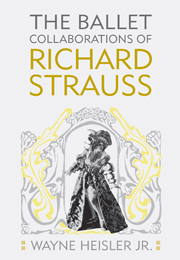Book contents
- Frontmatter
- Contents
- List of Illustrations
- Acknowledgments
- Introduction: Richard Strauss, Dance, and Ballet
- Part One Becoming a Ballet Composer, 1895–1914
- Part Two “To drive away all cloudy thoughts,” 1919–1941
- 3 The Strauss–Heinrich Kröller Ballettsoirée (1923) and Interwar Viennese Cultural Politics
- 4 Kitsch and Schlagobers (Whipped Cream, 1924)
- 5 Verstrausster Couperin, Verklingender Strauss, Verklungene Feste: Tanzvisionen aus Zwei Jahrhunderten (Bygone Celebrations: Dance Visions from Two Centuries, 1941)
- Epilogue
- Notes
- Works Cited and Consulted
- Index
- Eastman Studies in Music
5 - Verstrausster Couperin, Verklingender Strauss, Verklungene Feste: Tanzvisionen aus Zwei Jahrhunderten (Bygone Celebrations: Dance Visions from Two Centuries, 1941)
from Part Two - “To drive away all cloudy thoughts,” 1919–1941
Published online by Cambridge University Press: 12 September 2012
- Frontmatter
- Contents
- List of Illustrations
- Acknowledgments
- Introduction: Richard Strauss, Dance, and Ballet
- Part One Becoming a Ballet Composer, 1895–1914
- Part Two “To drive away all cloudy thoughts,” 1919–1941
- 3 The Strauss–Heinrich Kröller Ballettsoirée (1923) and Interwar Viennese Cultural Politics
- 4 Kitsch and Schlagobers (Whipped Cream, 1924)
- 5 Verstrausster Couperin, Verklingender Strauss, Verklungene Feste: Tanzvisionen aus Zwei Jahrhunderten (Bygone Celebrations: Dance Visions from Two Centuries, 1941)
- Epilogue
- Notes
- Works Cited and Consulted
- Index
- Eastman Studies in Music
Summary
My son will, no doubt, out of filial piety, play my tone poems from the manuscript for a while on the piano with a friend, and then that will end, too, and the world will continue on its course.
—Richard Strauss, preface to Aus dem Musikleben der Gegenwart (1908), translated by L. J. Lawrence“Truly a celebration for the eyes.” “A dance-conjuration in the spirit of the baroque.” “Sending shivers up the spine.” “One feels strangely moved, indeed shaken.” The impressions of four eyewitnesses, this euphoric litany was inspired by Verklungene Feste: Tanzvisionen aus Zwei Jahrhunderten, which had its premiere at Munich's Nationaltheater on April 5, 1941. Choreographed by Pia and Pino Mlakar, Verklungene Feste was comprised of reconstructions of baroque dances from Raoul Auger Feuillet's monumental Choréographie ou l'art de décrire la danse par caractères, figures et signes démonstratifs (Orchesography or the art of dancing, by characters and demonstrative figures, 1700). The Mlakars combined these eighteenth-century dances with newly composed ones in the style of the nineteenth century—that is, romantic ballet, with solo and group numbers that concentrated on Spitzentanz, or dance en pointe. For the musical component of this museumlike spectacle, Richard Strauss revisited his Tanzsuite aus Klavierstücken von François Couperin from the first tableau of the 1923 Viennese Ballettsoirée. Strauss expanded the Tanzsuite and shuffled in several numbers from a more recent collection of arrangements, eventually published as Divertimento: Klavierstücke von François Couperin für kleines Orchester bearbeitet von Richard Strauss (1942).
- Type
- Chapter
- Information
- The Ballet Collaborations of Richard Strauss , pp. 171 - 216Publisher: Boydell & BrewerPrint publication year: 2009



